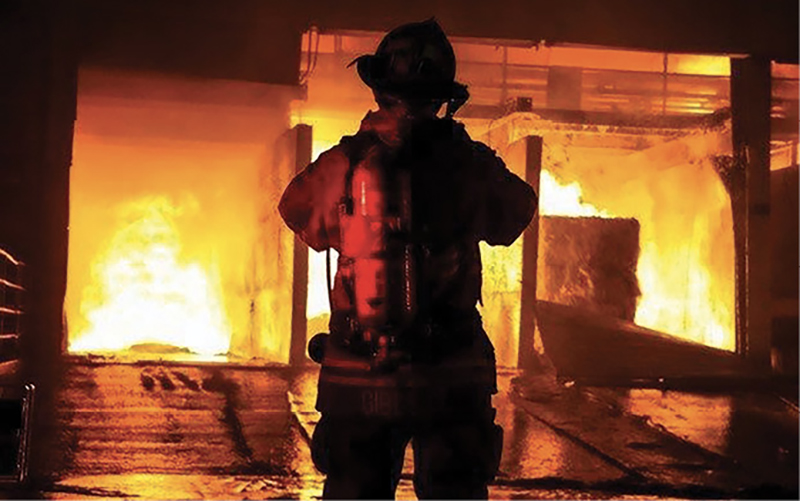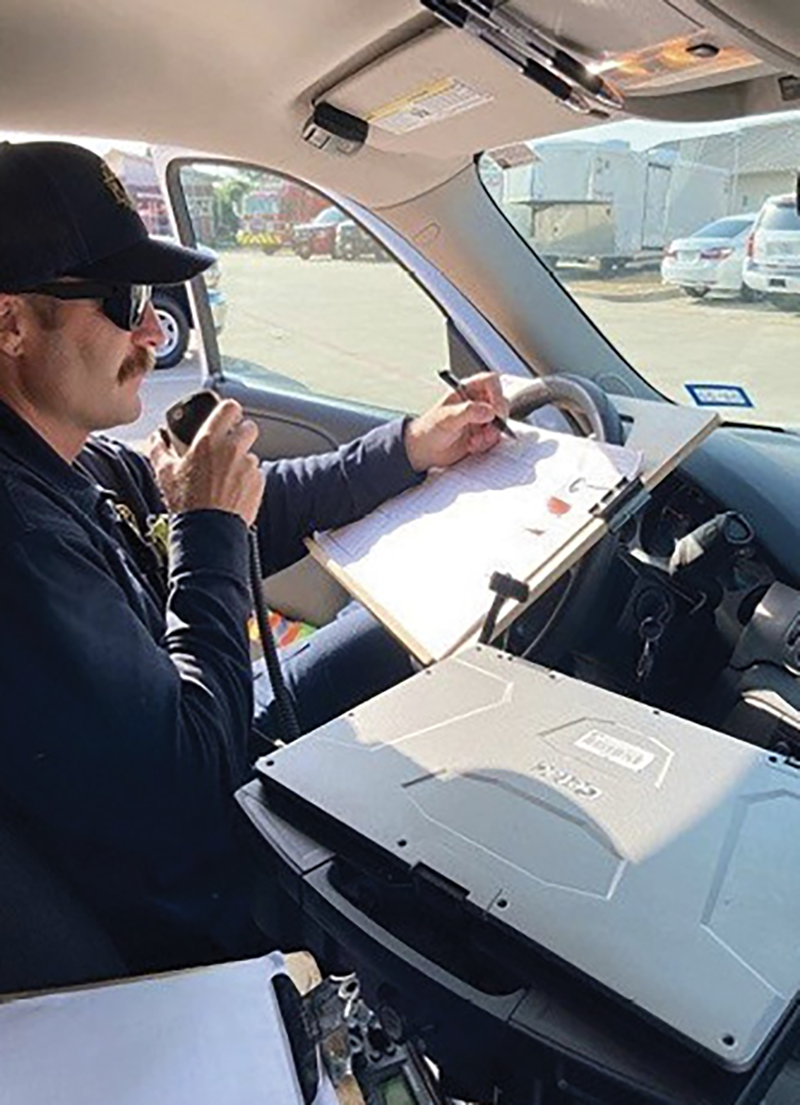By JAIME REYES
The fire service has a problem that we must address. It’s a shared problem that we’ve all experienced at some point in our careers: our communications, especially on the fireground. The truth is, we aren’t sure what to do about it.
Nearly every emergency incident has some sort of communications issue. Everything from too much talking to equipment failure, radio system deficiencies, unreadable transmissions, and so on—it’s a long list, and at least one of these issues rears its ugly head at every incident. What can we do about it? We know we need to be more concise, to “improve” our communications, but how exactly do we do that? How do we solve that problem? This article will highlight the importance of our communications by looking at each causal factor of the NIOSH 5 through the narrow lens of communications.
- Fireground Communications: Command Considerations and Responsibilities
- Conditions That Warrant Urgent Communications to Command
- Fireground Communications: From Size-Up to Mayday
- Communications Broke Down: An Excuse for a Serious Problem
The NIOSH 5
Originally created by Chief (Ret.) Ron Siarnicki in 2013, the National Institute for Occupational Safety and Health (NIOSH) “NIOSH 5” is an informal list of the top five contributing factors that lead to firefighter line-of-duty deaths (LODDs). Since then, this list has evolved to include the following top causal factors:
- Improper risk assessment.
- Lack of incident command.
- Lack of accountability.
- Inadequate communications.
- Lack of standard operating procedures (SOPs) or failure to follow SOPs.
These are the operational factors that lead to a fatality. In other words, when there is a firefighter LODD, the NIOSH investigation that follows usually reveals one or more of these five causal factors more than any other factor. These are the things that tend to go wrong on the fireground that lead to an LODD. Knowing this, why do these factors continue to occur? What are we missing? Is it possible that we could address all five causal factors by taking intentional steps toward improving our communications? Let’s take a closer look.
Improper Risk Assessment
This includes our initial and ongoing size-ups. When it comes to communications, the size-up isn’t the time for lengthy descriptions that take up valuable radio time. What we need on an initial size-up is more of a “snapshot.” Speaking for my department, the expectation for our officers is to keep it simple. Tell us what you’ve got; let us know you’ll be getting a 360° size-up and whether it’s a working fire. That’s it. For example, we can communicate, “Engine 4’s on scene, we’ve got a one-story house, smoke showing from a window on the Bravo side. I’ll be getting a 360. Make this a working fire.”

(1) Setting up groups and divisions not only helps with span of control and accountability but also reduces unnecessary radio traffic. (Photo by Justin Allred, OtherRed Photography.)
Lack of Incident Command
There are several ways we can address the lack of incident command through our communications. One of the simplest ways is for command to answer the radio. Notice I said “simplest” and not “easiest.” The late Chief (Ret.) Alan Brunacini from the Phoenix (AZ) Fire Department used to say that command must be “open for business.” Whoever is in command must answer the radio the first time, every time. This means that if I am in command, I must be aware of the many factors that could distract me from hearing and subsequently responding to radio traffic that was transmitted to command. The bottom line is that there is absolutely no excuse for a crew in the immediately dangerous to life or health environment to call command and not get an answer.
One of the most important ways we can address a “lack of incident command” through improving communications is by using divisions and groups. For example, when we create a group (i.e., “fire attack”), this immediately improves our span of control and frees up valuable airtime. Let’s say you have Engine 1 on fire attack with Engine 2 on a backup line and Engine 3 providing a second attack line. If command doesn’t create a group in this situation, he will be communicating with all three of these engine companies separately. That includes personnel accountability reports (PARs) and so on. This alone wouldn’t be terrible, but now add Truck 1 on “search,” Truck 2 on “vent,” Battalion 2 as “safety,” and a med unit (ambulance). In this scenario, command now has seven individual units with which he is responsible communicating and, in doing so, has clearly exceeded the ideal span of control.

(2) Battalion chief drivers/aides are an integral component of the “two-person command team.” Here, Battalion 1’s incident command engineer communicates with dispatch on the command channel, which frees up valuable radio time on the fireground channel. (Photo by author.)
This situation can be improved by creating a “fire attack” group with Engines 1, 2, and 3. One of them will be the supervisor. For example, this can be set up by communicating, “Engine 1 from command, you are now the fire attack group supervisor. You have Engine 1, Engine 2, and Engine 3 working for you.”
The only thing left to do here is to communicate this move to Engines 2 and 3. Now, when command communicates with “fire attack,” he is communicating with the supervisor (Engine 1’s officer in charge), who will communicate with Engines 1, 2, and 3. That communication will most likely be face-to-face, thereby reducing overall incident radio traffic.
The first-arriving unit is in charge and responsible for the actions taken on the fireground. However, to minimize the number of times we transfer command (reducing radio traffic), our department has the second engine take command. This has worked well for us since the result is that command is typically only transferred once, from the second engine to the first-arriving battalion chief (BC). This may not work everywhere, and this decision should be a departmental one based on your department’s resources and staffing.
Author’s note: A “pro tip” for BCs, when command has already been established (second engine) and the first BC arrives on scene, don’t just automatically take command. Consider the person who is currently in command. He is command and most likely making assignments (or about to). When the BC arrives and simply says, “Battalion 1’s on scene, Battalion 1 has command,” this puts an abrupt end to him being in command and doesn’t allow for a smooth transition.
Instead, communicate something such as, “Battalion 1’s on scene, I’m going to face-to-face with command.” This statement lets everyone know you’ve arrived, and they can expect you to take command soon. Next, the BC should go to command for the transfer; don’t make him come and find you.
Lack of Accountability
There are several ways that you can improve accountability through communications. The first one begins on arrival. When crews arrive, they should announce it on the fireground channel. If your department uses preassignments, that’s even better. For example, communicate, “Truck 5’s on scene, we’ll be taking vent/search.”
It’s important that this announcement is acknowledged. My department has had instances where the crew was on the wrong channel when they arrived so the announcement wasn’t heard. The officer realized he was on the wrong channel when his radio transmission didn’t get acknowledged. In my department, command will acknowledge this. For example, “Command received, Truck 5’s taking vent/search.”
If command has yet to be established, dispatch will acknowledge. How does dispatch know to do that? We provide a communications class to our dispatchers every year. Accountability is further addressed with our communications when we use groups and divisions as mentioned above.
Having regular PARs is another way to address accountability through communications. We do these at major benchmarks (i.e., fire under control, victim removed) or anytime we change operational modes from offensive to defensive, and so on.

(3) Command must always be open for business. There is absolutely no excuse for a crew working in the immediately dangerous to life or health environment to call command and not get an answer. [Photo by Chris Scheu, Plano (TX) Fire-Rescue.]
Inadequate Communications
Without any explanation, this can be difficult to address. “Inadequate” is a general term, and the reason it’s so general is that there are so many facets to fireground communications. Inadequate communications could mean a lot of different things to most of us, and it’s most likely dependent on personal experience.
The best way to address inadequate communications is by being intentional with your communications. There are two ways to do that. First, a department should formally adopt a communications model. For my department, it’s the “3 Cs”—Connect, Convey, Confirm. By adopting the 3 Cs model, our department is effectively stating, “This is how Plano Fire-Rescue communicates on the radio.”
After adopting this model, the department must provide some of the following specific communications expectations:
- Know how to operate your radio.
- Know when and, more importantly, when not to talk on the radio.
- Carry your radio and carry it properly on every incident.
- Use your department’s formally adopted communications model.
Lack of or Failure to Follow SOPs
This one is straightforward. Fire departments should have a specific SOP for communicating on the fireground. This SOP will include the department’s communications model and should also define the communications expectations. Further, it should contain the radio channel lineup as well as on-scene radio report guidance for size-ups; situation reports; and CAN reports (conditions, actions, and needs). Our communications SOP is titled “Emergency Operations Communications” and includes detailed expectations for portable radio usage and approved cleaning instructions. It provides guidance for command radio operations including the importance of establishing a command channel, which we use on all working fires. Our battalion driver [incident command engineer (“ICE”)] opens the command channel; this moves all communications between dispatch and command to this channel, which frees up a lot of radio time on the fireground channel and has greatly benefited our operations.
When evaluating our fireground operations alongside the NIOSH 5, we should do what we can to not only honor the sacrifices of those who have gone before us but also learn from prior incidents and make changes where we can. We do this as professionals so we can continue serving the public just as they expect. Although we can’t fully address every factor solely through communications, we can be intentional and take the lead by improving the areas of communications discussed here and perhaps make a difference or even change an outcome.
JAIME REYES is the operations assistant chief of the Plano (TX) Fire-Rescue. He is also a certified master firefighter and an instructor with the Texas Commission on Fire Protection. He has a BS degree from Texas A&M University.

